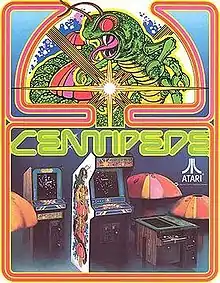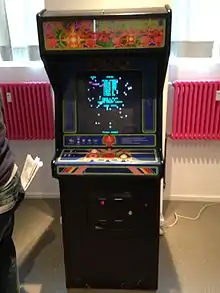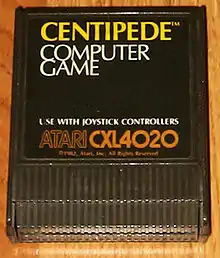Centipede (video game)
Centipede is a 1980 fixed shooter arcade game developed and published by Atari, Inc. It was designed by Dona Bailey and Ed Logg. It was one of the most commercially successful games from the golden age of arcade video games. The player fights off centipedes, spiders, scorpions and fleas, completing a round after eliminating the centipede that winds down the playing field. An arcade sequel, Millipede, followed in 1982.
| Centipede | |
|---|---|
 Arcade promotional flyer | |
| Developer(s) | Atari, Inc. |
| Publisher(s) | Atari, Inc. |
| Designer(s) | Dona Bailey Ed Logg |
| Programmer(s) | Dona Bailey Ed Logg |
| Series | Centipede |
| Platform(s) | Arcade, Apple II, Atari 2600, Atari 5200, Atari 7800, Atari 8-bit family, BBC Micro, ColecoVision, Commodore 64, IBM PC, Intellivision, TI-99/4A, VIC-20, Game Boy |
| Release | Arcade
|
| Genre(s) | Fixed shooter |
| Mode(s) | Single-player, multiplayer |
Centipede was ported to Atari's own Atari 2600, Atari 5200, Atari 7800, and Atari 8-bit family. Under the Atarisoft label, the game was sold for the Apple II, Commodore 64, ColecoVision, VIC-20, IBM PC (as a self-booting disk), Intellivision, and TI-99/4A.[1] Superior Software published the port for the BBC Micro. Versions for the Game Boy and Game Boy Color were also produced, as well as a version for the short-lived Game.com developed by Handheld Games and published by Tiger Electronics.
Gameplay

In the original arcade version: The player's fighter is represented by a small insect-like head at the bottom of the screen called the Bug Blaster. The player moves it around the bottom area of the screen with a trackball and fires small darts at a segmented centipede advancing from the top of the screen down through a field of mushrooms. Each segment of the centipede becomes a mushroom when shot; shooting one of the middle segments splits the centipede into two pieces at that point. Each piece then continues independently on its way down the screen, with the rear piece sprouting its own head. If the centipede head is destroyed, the segment behind it becomes the next head. Shooting the head is worth 100 points while the other segments are 10. The centipede starts at the top of the screen, traveling either left or right. When it touches a mushroom or reaches the edge of the screen, it descends one level and reverses direction. The player can destroy mushrooms (a point each) by shooting them, but each takes four shots to destroy. At higher levels, the screen can become increasingly crowded with mushrooms due to player/enemy actions, causing the centipede to descend more rapidly.

Once the centipede reaches the bottom of the screen, it moves back and forth within the player area and one-segment "head" centipedes will periodically appear from the side. This continues until the player has eliminated both the original centipede and all heads. When all the centipede's segments are destroyed, another one enters from the top of the screen. The initial centipede is 10 or 12 segments long, including the head; each successive centipede is one segment shorter and accompanied by one detached, faster-moving head. This pattern continues until all segments are separate heads, after which it repeats with a single full-length centipede.
The player also encounters other creatures besides the centipedes. Fleas drop vertically and disappear upon touching the bottom of the screen, occasionally leaving a trail of mushrooms in their path when only a few mushrooms are in the player movement area; they are worth 200 points and takes two shots to destroy. Spiders move across the player area in a zig-zag pattern and eat some of the mushrooms; they are worth 300, 600, or 900 points depending on how close the player shoots it. Scorpions move horizontally across the screen, turning every mushroom they touch into poison mushrooms. Scorpions are also worth the most points of all enemies with 1,000 points each. A centipede touching a poison mushroom will attack straight down toward the bottom, then return to normal behavior upon reaching it. This "poisoned" centipede can be both beneficial and detrimental to the player; the player can destroy them rapidly as it descends down, while at the same time, they can be very challenging to avoid, especially if already split into multiple segments.
The Bug Blaster will be destroyed when hit by any enemy, after which any poisonous or partially damaged mushrooms revert to normal. 5 points are awarded for each regenerated mushroom. The player gains extra lives every 12,000 points (10,000 in several ported versions).
Development
Dona Bailey and Ed Logg developed Centipede for Atari.[2] Logg, a supervisor, said that he did the design, while Bailey did about half of the programming.[3] Bailey was one of the few female game programmers in the industry.[4] Logg stated that the game was intended to attract women players; he believed that its design was not biased by sex, unlike a fighting or sports game. Bailey said, "I really like pastels ... I really wanted it to look different, to be visually arresting."[5][3] They succeeded; Centipede was one of the first arcade coin-operated games to have a significant female player base.[6] How to Win Video Games (1982) estimated that half of its players and 60% of Pac-Man's were women, while 95% of Defender players were men.[7]
Reception

In 1983, Softline readers named Centipede ninth on the magazine's Top Thirty list of Atari 8-bit programs by popularity.[8] The game received the award for "1984 Best Computer Action Game" at the 5th annual Arkie Awards where the judges described it as "pack[ing] a real roundhouse punch", and suggested that some "insist that [the Centipede] Atari cartridge is the best home-arcade edition you can buy".[9]:28 David H. Ahl of Creative Computing Video & Arcade Games said that the Atari 5200 version was "delightful fun".[10]
In a 1984 Video review of the Apple II version of the game, Bill Kunkel and Arnie Katz commented that "the graphic limits of the Apple crimp the style," and expressed disappointment in the game's "sluggish" interfacing with trackball controllers.[11]
In 1996, Next Generation listed the arcade version as number 84 on their "Top 100 Games of All Time", praising the cool concept, trackball control, and that it is accessible enough that "any human on the planet can play it well enough to enjoy it" yet "hard enough that even excellent gamers find it challenging."[12]
Legacy
Re-releases
- The game was included in the Sega Genesis Arcade Classics release, including this game as one in three. There was also a Game Gear game under the same title, and a similar Master System compilation titled Arcade Smash Hits.
- The game was released for Microsoft Windows 3.x as part of the Microsoft Arcade package in 1993.
- Accolade released a version for the Game Boy in 1995, as part of their Arcade Classics series. This version is notable for having background music in the title screen and different sound effects compared to the other ports.
- The game was included in the Midway Games published Arcade's Greatest Hits: The Atari Collection 1 for the Sega Saturn, Super Nintendo Entertainment System, and the PlayStation.
- The arcade original was included in the PlayStation and Dreamcast versions of the Centipede 3D remake, replacing the arcade mode from the PC and Macintosh versions.
- It is also included in Atari Arcade Hits 1, Atari Greatest Hits, Atari Anniversary Edition and Atari: 80 Classic Games in One!.
- The game has also been made available for the Xbox and PlayStation 2 (in both arcade and Atari 2600 versions) as part of Atari Anthology in 2004.
- The Xbox Live Arcade and PlayStation Portable's Atari Arcade Classics version was bundled with the sequel Millipede, which included an "evolution mode", featuring high-definition graphics and special effects like motion blur, trails, and particle-based explosions.[13]
- 'The game was released via Xbox Live Arcade for the Xbox 360 on May 2, 2007.
- Glu Mobile released a licensed cellular phone version of Centipede that includes the original game as well as updated gameplay, skins, and modes.[14]
- In 2008, Atari released the game for the iPhone and iPod Touch.
- The game was also made available on Retro Atari Classics for the DS alongside a graffiti themed version, as well as Atari Greatest Hits Volume 1 for the same system with both the Arcade and 2600 versions playable.
- Both the arcade and 2600 versions were released again in 2016 as part of Atari Vault.
Sequels and remakes
Centipede was followed by Millipede in 1982.
In 1992, Atari Games developed a prototype of an arcade game called Arcade Classics for their 20th anniversary, which includes Missile Command 2 and Super Centipede with co-op 2-player mode.[15]
A 3D fantasy role-playing game based on the original game was being developed by Dark Science for the Atari Jaguar CD under the working title Centipede 2000.[16] The source code of the project no longer exists and the only remaining proof of its existence is a short video clip from the developer.[17][18][19]
In 1998, after acquiring the intellectual property of Atari from then-owner JT Storage, Hasbro Interactive released a new version of the game for Microsoft Windows, PlayStation, Dreamcast, and Mac OS. It is very different from the original: 3D graphics, free movement around the map, and a campaign which can be played in single-player or multiplayer mode.
In 2011, Atari, SA released Centipede: Infestation for Nintendo 3DS and Wii.
In 2021, GameTaco released Centipede: Cash Blast for iOS.[20]
Clones
The Centipede concept was widely cloned, especially for home systems.
Arcade clones
Home system clones
- Bug Attack, for the Apple II in 1981 by Cavalier Computer[24]
- Arachnoid, for the VIC-20 in 1982 by UMI
- Arthropod, for the TI-99/4A in 1983 by North Hills
- Aqua Attack, for the BBC Micro as part of the Welcome disk/tape with the BBC Master
- Bug Blaster, for Commodore 64, BBC Micro, and Acorn Electron in 1983 by Alligata[25]
- Bug Off!, for the Atari 8-bit family in 1982 by Adventure International[26]
- Caterpillar, by Aardvark Software for the TRS-80 Color Computer[27][28]
- Centi-Bug, for the ZX Spectrum in 1983 by DK'Tronics (titled Centipede on screen)[29]
- Exterminator, by Nüfekop Software and Bubble Bus Software in 1982 for the VIC-20 and the Commodore 64
- Katerpillar Attack (Katerpillar, Kater-Pillar, or Katerpillar II) Tom Mix Software TRS-80 Color Computer, Dragon 32[27][30][31]
- Maggotmania, in 1983 for the Commodore 64 by Commodore
- Megalegs, 1982 for the Atari 8-bit family by Megasoft[32]
- Megapede, for the ZX Spectrum in 1983 by Computerware[33]
- Mouse Stampede for the Macintosh, by Mark of the Unicorn in 1984
- Myriapede, for the Atari 8-bit family in 1983
- Mushroom Alley, for the Commodore 64 in 1983 by Victory Software
- Spectipede, for the ZX Spectrum in 1983 by R&R Software
- Video Vermin, for the VIC-20 in 1982 by UMI[34]
- Wiggle Worm, for the TRS-80 Color Computer in 1984 by Chromasette[35]
- Decipede, a type-in version for the Commodore 64 published by COMPUTE!'s Gazette in January 1987[36]
- Apeiron, for Mac OS in 1995 by Ambrosia Software
- Champ Centiped-em, for MS-DOS in 1997 by CHAMProgramming[37]
In other media
In 1983, Milton Bradley released a board game based on the video game. The board game pits two players against each other in a race to be the first person to the opponent's home base with a centipede. Each player can utilize a blaster, as well as a scorpion and spider, to slow the opposing centipede's advance.[38] A new board game based on Centipede was published by IDW Publishing in 2017.[39]
In 1989, a deadpan narration describing the original game appeared on side 2 of Negativland's third cassette release, The Weatherman (SSTC902), which consisted of clips from the live Over the Edge radio show sometime between 1982 and 1984. The narrator may be Ed Logg.[40]
American Indie Rock band The Strokes used promotional artwork for the game on their 2003 single, Reptilia.
Centipede appears in the film Pixels.[41]
In May 2016, It was announced that Emmett/Furla/Oasis Films has closed a deal to partner with Atari to produce and finance both Centipede and Missile Command.[42]
Competitive arena
The game was chosen for the final round of the 1981 Atari World Championships run by Tournament Games International. The men's champion was Eric Ginner and the women's champion was Ok-Soo Han.[43]
The world record score on the arcade version of Centipede was 16,389,547 points by Jim Schneider of the USA on August 1, 1984.[44]
Donald Hayes of Windham, New Hampshire, USA, scored a world record 7,111,111 points under tournament rules on the arcade version of Centipede on November 5, 2000.[45][46]
References
- "TI-99/4A-Pedia: Centipede". Retrieved 2020-06-06.
- Ortutay, Barbara (June 30, 2012). "Dona Bailey, a rare female programmer in Atari's early days, recalls birth of 'Centipede'". VancouverDesi.com. Associated Press / DesiWireFeed. Archived from the original on October 9, 2012. Retrieved July 15, 2012.
- Rouse, Richard III (2010). "Chapter 6: Interview: Ed Logg". Game Design: Theory and Practice. Jones & Bartlett Learning. pp. 93–94. ISBN 9781449633455.
- Burnham, Van (2001). Supercade: a visual history of the videogame age 1971-1984. Cambridge, MA: MIT Press. p. 220. ISBN 0-262-02492-6. Archived from the original on 2008-12-19. Retrieved 2008-12-14.
- Krueger, Anne (March 1983). "Welcome to the Club". Video Games. p. 51. Retrieved 26 May 2014.
- Kent, Steven (2001). from Pong to Pokémon and beyond: The Ultimate History of Video Games: the story behind the craze that touched our lives and changed the world. Roseville, California: Prima Publishing. pp. 160–162. ISBN 0-7615-3643-4.
- How to Win Video Games. Pocket Books. 1982. pp. 83–84, 87. ISBN 0-671-45841-8.
- "The Most Popular Atari Program Ever". Softline. March 1983. p. 44. Archived from the original on 2014-07-29. Retrieved 28 July 2014.
- Kunkel, Bill; Katz, Arnie (February 1984). "Arcade Alley: The 1984 Arcade Awards, Part II". Video. Vol. 7 no. 11. Reese Communications. pp. 28–29. ISSN 0147-8907.
- Ahl, David H. (Spring 1983). "Atari 5200 Advanced Game System". Creative Computing Video & Arcade Games. p. 46. Archived from the original on 2017-11-07. Retrieved 2017-11-06.
- Kunkel, Bill; Katz, Arnie (March 1984). "Arcade Alley: We Still Want Action". Video. Vol. 7 no. 12. Reese Communications. p. 23. ISSN 0147-8907.
- "Top 100 Games of All Time". Next Generation. No. 21. Imagine Media. September 1996. p. 43.
- "glu games - Centipede". 2007-10-06. Archived from the original on 2007-10-06. Retrieved 2011-02-09.
- "Arcade Classics Videogame by Atari Games (1992) - The International Arcade Museum and the KLOV". Arcade-museum.com. Retrieved 2011-02-09.
- Willard (November 4, 2014). "Canceled Centipede RPG on Atari Jaguar CD". racketboy.com. Retrieved 2018-10-28.
- Willard (May 4, 2003). "Centipede 2000". AtariAge. Retrieved 2018-09-22.
- Reutter, Hans (November 19, 2000). "Unreleased Or Unfinished Jaguar Games - Centipede 2000 (working title)". cyberroach.com. Archived from the original on 2018-04-02. Retrieved 2018-09-22.
- Jean La Montarde (January 24, 2014). Centipede 2000 for Atari Jaguar - Engine demo. YouTube.
- https://apps.apple.com/us/app/atari-centipede-cash-blast/id1449639446
- "War Of The Bugs Videogame by Food and Fun Corp./Armenia Ltd. (1981) - The International Arcade Museum and the KLOV". Arcade-museum.com. Retrieved 2011-02-09.
- "Jackler Videogame by Konami (1982) - The International Arcade Museum and the KLOV". Arcade-museum.com. Retrieved 2011-02-09.
- Classic Game Room reviews COLECOVISION ROLLER CONTROLLER (YouTube) (YouTube). Lord Karnage. 2008. Event occurs at 4:45. Archived from the original on 2015-01-10. Retrieved April 2, 2014.
- "Bio and Gameography of Jim Nitchals (Bug Attack, Microwave, Teleport...)". Game Designers Remembered. Archived from the original on 2016-08-22. Retrieved 2016-07-13.
- http://www.lemon64.com/?mainurl=http%3A//www.lemon64.com/games/list.php%3Fpublisher%3DAlligata+Software
- "Bug Off!". Atari Mania. Archived from the original on 2016-08-29. Retrieved 2016-07-13.
- "Home Computer Games: TRS-80 Color Computer Games". Atarimagazines.com. 2008-04-25. Archived from the original on 2011-02-26. Retrieved 2011-02-09.
- "Caterpillar (Dave Edson)". Nitros9.lcurtisboyle.com. Archived from the original on 2011-01-23. Retrieved 2011-02-09.
- "Centi-Bug". World of Spectrum. Archived from the original on 2017-10-16. Retrieved 2017-08-31.
- "Katerpillar Attack". Nitros9.lcurtisboyle.com. Archived from the original on 2010-12-29. Retrieved 2011-02-09.
- "Dragon Software Library". Dragon-it.co.uk. Archived from the original on 2010-11-24. Retrieved 2011-02-09.
- "Megalegs". Atari Mania. Archived from the original on 2016-08-29. Retrieved 2016-07-13.
- "Megapede". Nitros9.lcurtisboyle.com. Archived from the original on 2010-11-30. Retrieved 2011-02-09.
- "VIC-20 Cartridge Software Reviews". Zimmers.net. Archived from the original on 2011-06-09. Retrieved 2011-02-09.
- Boyle, L. Curtis. "Wiggle Worm". The Tandy Color Computers Game List. Archived from the original on 2016-06-29. Retrieved 2016-07-17.
- "COMPUTE!'s Gazette Index, page 1". Atarimagazines.com. Archived from the original on 2011-03-03. Retrieved 2011-02-09.
- "CHAMP Centipede-em". The CHAMP Games Fan Page. Archived from the original on 2017-08-31. Retrieved 2017-08-31.
- "Centipede: The Board Game". SydLexia.com. Archived from the original on 2016-11-29. Retrieved 7 April 2017.
- "IDW Games Announces Atari Partnership". IDW Publishing. 8 March 2017. Archived from the original on 2017-04-06. Retrieved 7 April 2017.
- Negativland, The Weatherman. Cassette only, SST Records SSTC902. Negativland Discography Archived 2015-09-24 at the Wayback Machine at The Skeptic Tank.
- "Classic video game characters unite via film 'Pixels'". Philstar. July 23, 2014. Archived from the original on 2014-07-23. Retrieved July 23, 2014.
- Fleming, Jr, Mike (May 12, 2016). "Atari Classic Arcade Games Centipede & Missile Command Headed For Big Screen". Deadline. Archived from the original on 2016-05-13. Retrieved 2016-05-13.
- "1981 Atari World Championships History". 2012-11-12. Archived from the original on 2017-08-31. Retrieved 2017-08-31.
- "Twin Galaxies Centipede Rankings". Archived from the original on 2017-08-30. Retrieved 2017-08-30.
- "Guinness World Records 2008 - Gamer's Edition", page 240
- "Welcome to Twin Galaxies". Twingalaxies.com. Archived from the original on 2010-12-01. Retrieved 2011-02-09.
| Wikimedia Commons has media related to Centipede (video game). |
External links
- Centipede at the Killer List of Videogames
- Centipede at the Arcade History database
- Atari's official online version of Centipede